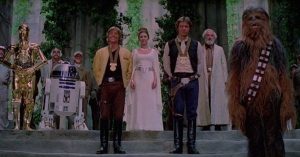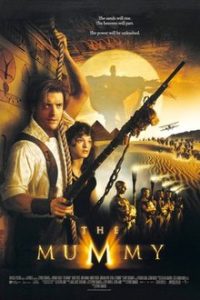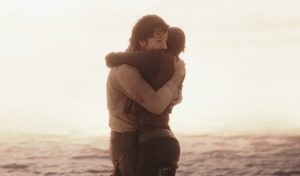I’ve reached the sequel trilogy in my Star Wars rewatch, which means it’s almost over (but just as a new season of The Mandalorian is coming on, so there’s still new Star Wars). I actually like the sequel movies, mostly because I love the characters. The casting is perfect, and they all have a wonderful dynamic. I just wish that some of the storytelling around these characters had been better.
For instance, I watched The Force Awakens last weekend, and it struck me that the story in this movie is fundamentally flawed, with one giant, glaring problem: It doesn’t have a clear story goal, which means it doesn’t really have a protagonist.
A story basically boils down to a protagonist trying to achieve a story goal, with conflicts and obstacles making it difficult and some kind of stakes if they don’t succeed. The protagonist is the one who strives for and achieves (or doesn’t, if the story is more tragic) the story goal, with the struggle being difficult enough that they have to transform or resolve some personal issue in order to achieve it. Take The Lord of the Rings. The story goal is to destroy the ring. If they fail, then Sauron will take over all of Middle Earth and destroy it. Sauron and all his forces are trying to get the ring before they can destroy it, and if Sauron gets the ring, he’ll have ultimate power. While all the good guys are on board with the plan to destroy the ring, it’s Frodo who’s the protagonist. He’s the one who has to stick with it, and the experience leaves him transformed, so that he no longer really fits into his old world.
To analyze The Force Awakens, it helps to compare it to the original Star Wars, since to a large extent it was essentially a remake. Spoilers ahead for the whole plot for both movies.
In the original movie, the story goal, conflict, and stakes were laid out in the opening crawl: the rebels wanted to destroy the Death Star and the Empire wanted to stop them from getting the plans that they could use to destroy the Death Star. If the rebels failed, the Empire would be able to blow up planets (and might use that capability to destroy the rebellion). The whole movie is about the threat of the Death Star and the efforts to get the plans to the rebels so they could blow up the Death Star. While all the good guys are on Team Destroy the Death Star, Luke is our protagonist, since he’s the one who undergoes a character change in order to do so. He has to choose the Force over technology and accept his heritage as a potential Jedi. But he’s not a very strong protagonist, in the sense that he’s not really driving the action. For most of the story, he’s forced into turning points by the actions of other characters rather than truly making decisions. He doesn’t step up and take initiative until he decides to rescue Princess Leia from the Death Star prison. His relationship to the story goal evolves through the course of the story. Initially, he’s just trying to get the plans to the rebels. Then he joins in the attack, wanting to help the rebels destroy the Death Star. It’s only at the last minute, after everyone else has been wiped out, that he actually takes on the goal of destroying the Death Star.
Now, The Force Awakens. Again, the opening crawl lays out the story goal and conflict. The Resistance needs to find Luke Skywalker. The First Order also wants to find him (to eliminate him). Our two forces are in opposition. The Resistance not only needs to get to Luke, but they need to stop the First Order from getting to him. Instead of needing to get Death Star plans to the rebels, they need to get the map to find Luke to the Resistance. That’s what the first half of the movie is about. Poe gives the plans to BB-8, who runs into Rey, who escapes from the planet with Finn and BB-8 and is trying to take BB-8 to the Resistance. Then she gets personally invested in the quest to find Luke when she has a disturbing experience with the Force, so she knows she needs to find him and get some training, but this also terrifies her, so she resists it and tries to run away.
And then the movie abruptly switches tracks. At almost exactly the halfway mark, we learn about Starkiller Base, which can blow up whole systems. Suddenly, the story goal veers over to being about destroying this base before it can destroy the Resistance. We get a few bits of the Luke story in Kylo Ren trying to get the map Rey saw out of her head, and I guess that’s kind of what the lightsaber fight is about (I suspect it was mostly because a Star Wars movie needs a lightsaber fight, but I think Kylo Ren was trying to keep Rey from getting away with the knowledge in her head and her latent Force powers), but the climax of the movie is about blowing up the base. Then we get back to the Luke story in an “oh yeah, that” way, with R2-D2 suddenly waking up and giving them the rest of the map, so Rey and Chewbacca can head off and find Luke.
So, which is the story goal, finding Luke or blowing up the base? The Luke story takes up most of the screen time. The base story doesn’t come up until midway through the movie, and then there are still bits of the Luke story woven in, plus the coda. There’s probably more conflict in the Luke story, since the First Order is not only trying to stop the Resistance from finding him, but they also want to find him themselves for their own reasons. Every bounty hunter, First Order sympathizer and criminal in the galaxy is on the lookout for BB-8. Rey has personal internal conflict relating to this quest. On the other hand, there’s no conflict at all in the resolution of it. R2 wakes up for Reasons. No one does anything to make that happen. Ultimately, finding Luke comes down to following a map. There’s no race against the bad guys, no one trying to get in their way. The conflict for the base plot mostly comes down to the First Order not wanting the base destroyed and sending some fighters out to intercept the Resistance attack force. All the effort to learn about the base comes in an offscreen recon mission, and then they have what Finn knows from having served on the base, so there’s not a lot of struggle.
But the stakes are all with the base story. If they don’t destroy this base, the First Order will be able to destroy anyone who opposes them and will probably wipe out the Resistance. On the Luke plot, we don’t really know why this is so urgent. As Luke himself says in the next movie, it’s not as though one old guy with a lightsaber is going to make that much of a difference. It’s mostly important because the audience knows Luke and wants to see him. I don’t think they ever articulate what will happen if they don’t find Luke. If the First Order caught up with them and they destroyed that thumb drive with the map to keep the bad guys from getting it, even if that meant the good guys couldn’t find Luke, what would the consequences be? We don’t know.
A test of the story goal is the role of the protagonist in making it happen and the effect on the protagonist. But who’s the protagonist of this story? Poe is involved in both plots. He’s the one who gets the map and sends it with BB-8 and he’s the one who blows up the base, but he doesn’t really go through any growth or change or personal struggle. Rey is the protagonist of the trilogy, but she’s not actually a driving force in either story here. She does help BB-8 and gets him to where he can return to the Resistance, and she has to change her mind about returning home instead of getting involved and about dealing with the Force when she sees for certain she has some kind of power she doesn’t understand, so she goes through some personal change related to the Luke plot. She has almost nothing to do with the base plot, aside from being present. I think this fuzziness about her role may have a lot to do with the reaction of some fans to this character (but that’s a topic for a whole other post).
It looks like in essentially remaking the original movie, what they did was divide that plot into two plots. Leia was on her way to recruit Obi-Wan when she was captured and had to send the plans with R2 (who may actually be the protagonist of the whole saga), but it’s likely her father’s real intent there wasn’t so much to bring in one old guy with a lightsaber, but rather to signal Obi-Wan that it was time to bring in Luke, since Luke would be Vader’s weakness (Leia would also work for that, but Bail was probably more open to using some kid he didn’t know as Vader bait than he would be to using his own daughter). Instead of weaving the threads together, they split the killer weapon and the old Jedi plots into separate elements that had nothing to do with each other.
I think it would have made for a stronger story if they’d ditched the killer weapon plot and fleshed out the Luke plot. What, specifically, did they need Luke for? Did they need a real Jedi to be able to deal with Snoke? Had Leia found a group of Force sensitive people who could be trained as Jedi, but needed someone to finish their training? And then build action around the search for Luke, so it takes more than following a map. They can’t follow the map because the First Order is tracking them, and they can’t lead them to Luke. They have to have a space battle to fend off the First Order. Let Rey still get captured and have to fight Kylo Ren and then escape. Maybe they do have to destroy the map to keep the First Order from getting it, so all seems lost, but then R2’s map points them in the general direction and Rey has to use the Force she’s been resisting to sense the Jedi temple.
It’s frustrating when professional screenwriters get something this basic wrong. It kind of feels like a movie made by committee by weaving together two different scripts. But at least I can boil down the problem here. I can’t figure out what The Phantom Menace is actually about or who the protagonist is supposed to be. Whatever George Lucas knew about story structure when writing the first movie, he totally forgot when it came to writing the prequels because there’s almost no structure there.



